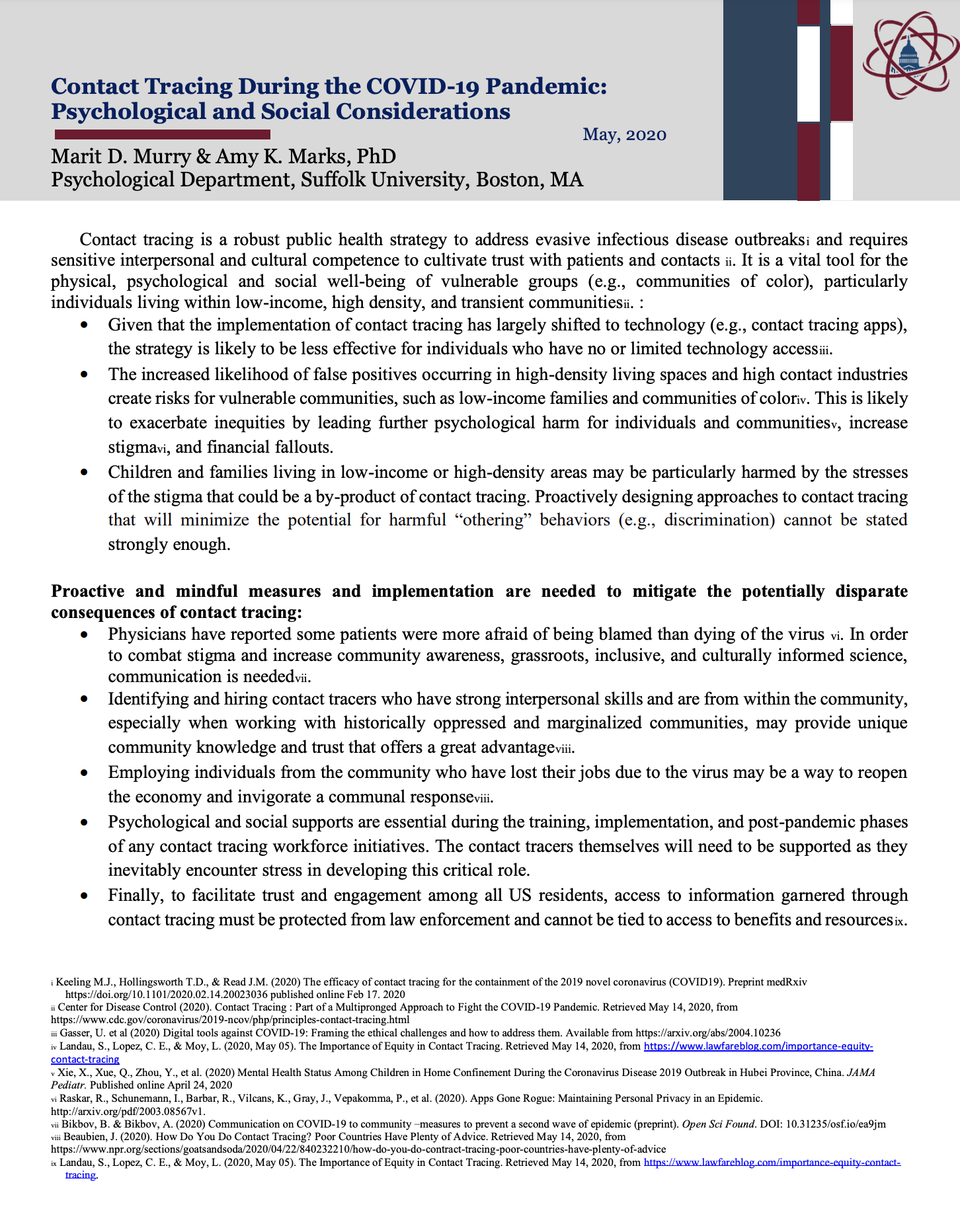
Contact tracing is a robust public health strategy to address evasive infectious disease outbreaks [i] and requires sensitive interpersonal and cultural competence to cultivate trust with patients and contacts [ii]. It is a vital tool for the physical, psychological and social well-being of vulnerable groups (e.g., communities of color), particularly individuals living within low-income, high density, and transient communities [ii]:
- Given that the implementation of contact tracing has largely shifted to technology (e.g., contact tracing apps), the strategy is likely to be less effective for individuals who have no or limited technology access [iii].
- The increased likelihood of false positives occurring in high-density living spaces and high contact industries create risks for vulnerable communities, such as low-income families and communities of color [iv]. This is likely to exacerbate inequities by leading further psychological harm for individuals and communities [v], increase stigma [vi], and financial fallouts.
- Children and families living in low-income or high-density areas may be particularly harmed by the stresses of the stigma that could be a by-product of contact tracing. Proactively designing approaches to contact tracing that will minimize the potential for harmful “othering” behaviors (e.g., discrimination) cannot be stated strongly enough.
Proactive and mindful measures and implementation are needed to mitigate the potentially disparate consequences of contact tracing:
- Physicians have reported some patients were more afraid of being blamed than dying of the virus [vi]. In order to combat stigma and increase community awareness, grassroots, inclusive, and culturally informed science, communication is needed [vii].
- Identifying and hiring contact tracers who have strong interpersonal skills and are from within the community, especially when working with historically oppressed and marginalized communities, may provide unique community knowledge and trust that offers a great advantage [viii].
- Employing individuals from the community who have lost their jobs due to the virus may be a way to reopen the economy and invigorate a communal response [viii].
- Psychological and social supports are essential during the training, implementation, and post-pandemic phases of any contact tracing workforce initiatives. The contact tracers themselves will need to be supported as they inevitably encounter stress in developing this critical role.
- Finally, to facilitate trust and engagement among all US residents, access to information garnered through contact tracing must be protected from law enforcement and cannot be tied to access to benefits and resources [ix].
End Notes / References
[i] Keeling M.J., Hollingsworth T.D., & Read J.M. (2020) The efficacy of contact tracing for the containment of the 2019 novel coronavirus (COVID19). Preprint medRxiv https://doi.org/10.1101/2020.02.14.20023036 published online Feb 17. 2020
[ii] Center for Disease Control (2020). Contact Tracing : Part of a Multipronged Approach to Fight the COVID-19 Pandemic. Retrieved May 14, 2020,from https://www.cdc.gov/coronavirus/2019-ncov/php/principles-contact-tracing.html
[iii] Gasser, U. et al (2020) Digital tools against COVID-19: Framing the ethical challenges and how to address them. Available from https://arxiv.org/abs/2004.10236
[iv] Landau, S., Lopez, C. E., & Moy, L. (2020, May 05). The Importance of Equity in Contact Tracing. Retrieved May 14, 2020, from https://www.lawfareblog.com/importance-equity-contact-tracing
[v] Xie, X., Xue, Q., Zhou, Y., et al. (2020) Mental Health Status Among Children in Home Confinement During the Coronavirus Disease 2019 Outbreak in Hubei Province, China. JAMA Pediatr. Published online April 24, 2020
[vi] Raskar, R., Schunemann, I., Barbar, R., Vilcans, K., Gray, J., Vepakomma, P., et al. (2020). Apps Gone Rogue: Maintaining Personal Privacy in an Epidemic. http://arxiv.org/pdf/2003.08567v1.
[vii] Bikbov, B. & Bikbov, A. (2020) Communication on COVID-19 to community –measures to prevent a second wave of epidemic (preprint). Open Sci Found. DOI: 10.31235/osf.io/ea9jm
[viii] Beaubien, J. (2020). How Do You Do Contact Tracing? Poor Countries Have Plenty of Advice. Retrieved May 14, 2020, from https://www.npr.org/sections/goatsandsoda/2020/04/22/840232210/how-do-you-do-contract-tracing-poor-countries-have-plenty-of-advice
[ix] Landau, S., Lopez, C. E., & Moy, L. (2020, May 05). The Importance of Equity in Contact Tracing. Retrieved May 14, 2020, from https://www.lawfareblog.com/importance-equity-contact-tracing.
The Research-to-Policy Collaboration (RPC) works to bring together research professionals and public officials to support evidence-based policy. Please visit their website to learn more.
Key Information
RPC Website
Research-to-Policy Collaboration
Publication DateMay 1, 2020
Topic Area(s)Community-Specific, Health
Resource TypeWritten Briefs
Share This Page
Contact tracing is a robust public health strategy to address evasive infectious disease outbreaks [i] and requires sensitive interpersonal and cultural competence to cultivate trust with patients and contacts [ii]. It is a vital tool for the physical, psychological and social well-being of vulnerable groups (e.g., communities of color), particularly individuals living within low-income, high density, and transient communities [ii]:
- Given that the implementation of contact tracing has largely shifted to technology (e.g., contact tracing apps), the strategy is likely to be less effective for individuals who have no or limited technology access [iii].
- The increased likelihood of false positives occurring in high-density living spaces and high contact industries create risks for vulnerable communities, such as low-income families and communities of color [iv]. This is likely to exacerbate inequities by leading further psychological harm for individuals and communities [v], increase stigma [vi], and financial fallouts.
- Children and families living in low-income or high-density areas may be particularly harmed by the stresses of the stigma that could be a by-product of contact tracing. Proactively designing approaches to contact tracing that will minimize the potential for harmful “othering” behaviors (e.g., discrimination) cannot be stated strongly enough.
Proactive and mindful measures and implementation are needed to mitigate the potentially disparate consequences of contact tracing:
- Physicians have reported some patients were more afraid of being blamed than dying of the virus [vi]. In order to combat stigma and increase community awareness, grassroots, inclusive, and culturally informed science, communication is needed [vii].
- Identifying and hiring contact tracers who have strong interpersonal skills and are from within the community, especially when working with historically oppressed and marginalized communities, may provide unique community knowledge and trust that offers a great advantage [viii].
- Employing individuals from the community who have lost their jobs due to the virus may be a way to reopen the economy and invigorate a communal response [viii].
- Psychological and social supports are essential during the training, implementation, and post-pandemic phases of any contact tracing workforce initiatives. The contact tracers themselves will need to be supported as they inevitably encounter stress in developing this critical role.
- Finally, to facilitate trust and engagement among all US residents, access to information garnered through contact tracing must be protected from law enforcement and cannot be tied to access to benefits and resources [ix].
End Notes / References
[i] Keeling M.J., Hollingsworth T.D., & Read J.M. (2020) The efficacy of contact tracing for the containment of the 2019 novel coronavirus (COVID19). Preprint medRxiv https://doi.org/10.1101/2020.02.14.20023036 published online Feb 17. 2020
[ii] Center for Disease Control (2020). Contact Tracing : Part of a Multipronged Approach to Fight the COVID-19 Pandemic. Retrieved May 14, 2020,from https://www.cdc.gov/coronavirus/2019-ncov/php/principles-contact-tracing.html
[iii] Gasser, U. et al (2020) Digital tools against COVID-19: Framing the ethical challenges and how to address them. Available from https://arxiv.org/abs/2004.10236
[iv] Landau, S., Lopez, C. E., & Moy, L. (2020, May 05). The Importance of Equity in Contact Tracing. Retrieved May 14, 2020, from https://www.lawfareblog.com/importance-equity-contact-tracing
[v] Xie, X., Xue, Q., Zhou, Y., et al. (2020) Mental Health Status Among Children in Home Confinement During the Coronavirus Disease 2019 Outbreak in Hubei Province, China. JAMA Pediatr. Published online April 24, 2020
[vi] Raskar, R., Schunemann, I., Barbar, R., Vilcans, K., Gray, J., Vepakomma, P., et al. (2020). Apps Gone Rogue: Maintaining Personal Privacy in an Epidemic. http://arxiv.org/pdf/2003.08567v1.
[vii] Bikbov, B. & Bikbov, A. (2020) Communication on COVID-19 to community –measures to prevent a second wave of epidemic (preprint). Open Sci Found. DOI: 10.31235/osf.io/ea9jm
[viii] Beaubien, J. (2020). How Do You Do Contact Tracing? Poor Countries Have Plenty of Advice. Retrieved May 14, 2020, from https://www.npr.org/sections/goatsandsoda/2020/04/22/840232210/how-do-you-do-contract-tracing-poor-countries-have-plenty-of-advice
[ix] Landau, S., Lopez, C. E., & Moy, L. (2020, May 05). The Importance of Equity in Contact Tracing. Retrieved May 14, 2020, from https://www.lawfareblog.com/importance-equity-contact-tracing.
The Research-to-Policy Collaboration (RPC) works to bring together research professionals and public officials to support evidence-based policy. Please visit their website to learn more.

Key Information
RPC Website
Research-to-Policy Collaboration
Publication DateMay 1, 2020
Topic Area(s)Community-Specific, Health
Resource TypeWritten Briefs
Share This Page
LET’S STAY IN TOUCH
Join the Evidence-to-Impact Mailing List
Keep up to date with the latest resources, events, and news from the EIC.




